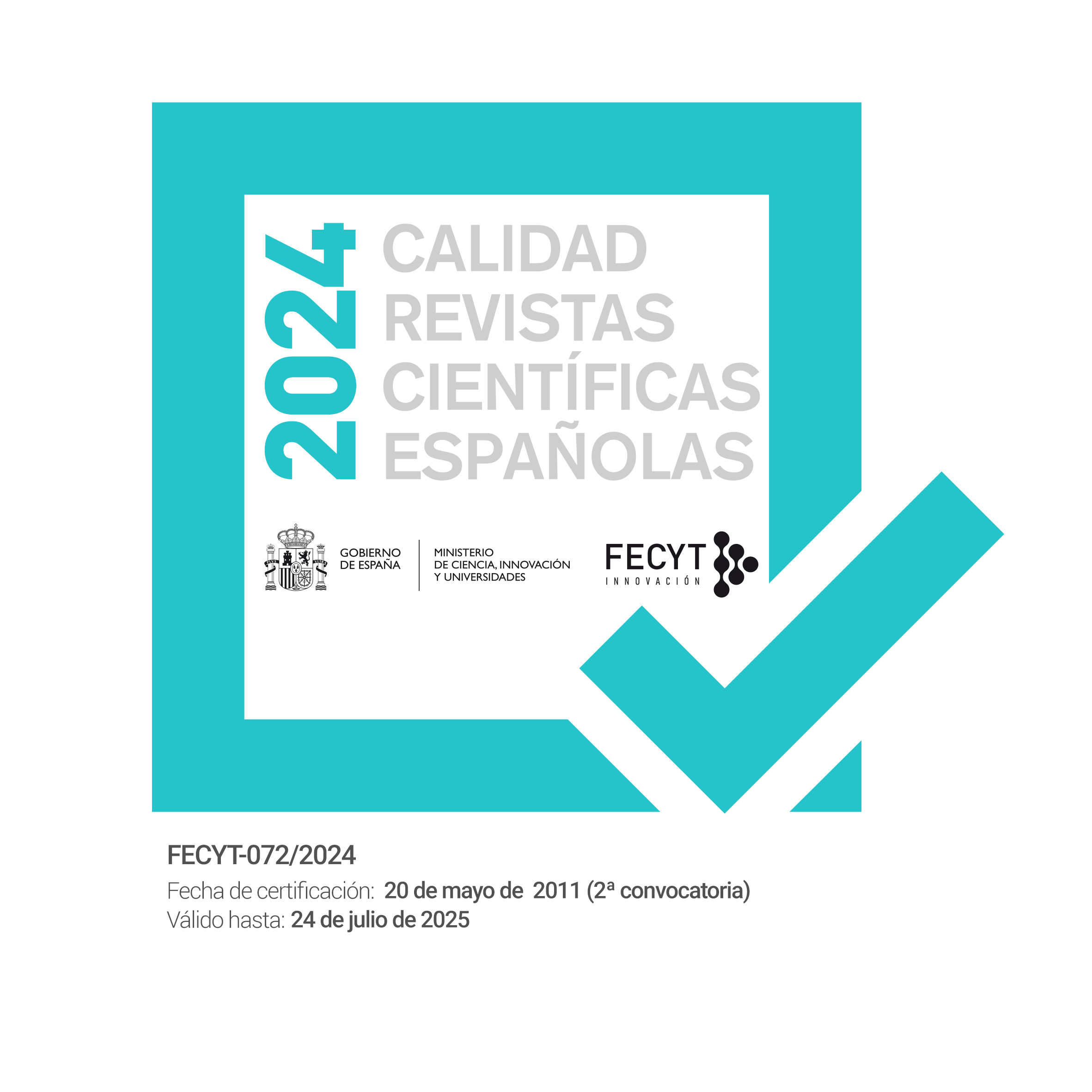Primer registro de Tetracona (Agrotera) amathealis (Walker, 1859) sobre un híbrido de Eucalyptus grandis W. Hill × Eucalyptus pellita F. Muell. (Myrtaceae) en Indonesia (Lepidoptera: Crambidae: Spilomelinae)
DOI:
https://doi.org/10.57065/shilap.279Palabras clave:
Lepidoptera, Crambidae, Spilomelinae, Tetracona amathealis, primer registro, IndonesiaResumen
Tetracona amathealis (Walker, 1859) (Lepidoptera: Crambidae) previamente es conocida de Australia y New Guinea, donde se alimenta del oriundo Eucalyptus tereticornis Sm. (Myrtaceae). El objetivo de este estudio fue registrar, por primera vez, T. amathealis en Indonesia así como registrar una nueva planta nutricia para el insecto. Manualmente, fueron recogidos de un híbrido de Eucalyptus grandis W. Hill. × Eucalyptus pellita F. Muell. Plantación comercial en Riau, Sumatra, Indonesia y una simple muestra enviada para identificación vía análisis molecular. Nuestras conclusiones revelaron que el enfoque molecular usado (a través del ordenación en serie de su gen mitocondrial mt-COI) permitió la identificación de la especie con éxito como T. amathealis. Este insecto se registra, por primera vez, en Indonesia sobre una nueva planta nutricia un híbrido de E. grandis × E. pellita.
Descargas
Estadísticas globales ℹ️
|
492
Visualizaciones
|
223
Descargas
|
|
715
Total
|
|
Citas
ALTSCHUL, S. F., GISH, W., MILLER, W., MYERS, E. W. & LIPMAN, D. J., 1990.– Basic local alignment search tool.– Journal of Molecular Biology, 215(3): 403-410. DOI: https://doi.org/10.1016/S0022-2836(05)80360-2
ANTONINI, G., COLETTI, G., SERRANI, L., TRONCI, C., CRISTOFARO, M. & SMITH, L., 2009.– Using molecular genetics to identify immature specimens of the weevil Ceratapion basicorne (Coleoptera: Apionidae).– Biological Control, 51(1): 152-157. DOI: https://doi.org/10.1016/j.biocontrol.2009.06.010
BARRERA, G. P., VILLAMIZAR, L. F., ESPINEL, C., QUINTERO, E. M., BELAICH, M. N., TOLOZA, D. L., GHIRINGHELLI, P. D. & VARGAS, G., 2017.– Identification of Diatraea spp. (Lepidoptera: Crambidae) based on cytochrome oxidase II.– PLoS ONE, 12(9): e0184053. DOI: https://doi.org/10.1371/journal.pone.0184053
BOOTH, T. H., 2019.– Assessing the thermal adaptability of tree provenances: An example using Eucalyptus tereticornis.– Australian Forestry, 82(4): 176-180. DOI: https://doi.org/10.1080/00049158.2019.1680594
CHAO, K. H., BARTON, B., PALMER, S. & LANFEAR, R., 2020.– SangeranalyseR: Simple and interactive analysis of Sanger sequencing data in R.– Bioinformatics: doi: https://doi.org/10.1101/2020.05.18.102459 (preprint). DOI: https://doi.org/10.1101/2020.05.18.102459
CHEN, K., HORAK, M., DU, X. & ZHANG, D., 2017.– Revision of the Australian species of Agrotera Schrank (Lepidoptera: Pyraloidea: Crambidae: Spilomelinae).– Zootaxa, 4362(2): 213-224. DOI: https://doi.org/10.11646/zootaxa.4362.2.2
FELSENSTEIN, J., 1981.– Evolutionary trees from DNA sequences: A maximum likelihood approach.– Journal of Molecular Evolution, 17(1): 368-376. DOI: https://doi.org/10.1007/BF01734359
FUJIWARA, K., UECHI, N., SHIMIZU, Y., TODA, S., INOUE, H., YAMAGUCHI, T., IWANAMI, T. & FUJIKAWA, T., 2017.– Effective molecular detection of Diaphorina citri Kuwayama (Hemiptera: Liviidae) in bulk insect samples from sticky traps.– Journal of Applied Entomology, 141(1-2): 61-66. DOI: https://doi.org/10.1111/jen.12315
HERBISON-EVANS, D., HACOBIAN, B. & CROSSLEY, S., 2013.– Agrotera amathealis (Walker, 1859). Australian caterpillars and their butterflies and moths.– Available from http://lepidoptera.butterflyhouse. com.au/spil/amathealis.html (accessed 18 August 2020).
INAIL, M. A., HARDIYANTO, E. B. & MENDHAM, D. S., 2019.– Growth responses of Eucalyptus pellita F. Muell plantations in South Sumatra to macronutrient fertilisers following several rotations of Acacia mangium Willd.– Forests, 10(12): 1054. DOI: https://doi.org/10.3390/f10121054
JIE, L. L., YANG, J. B. & LI, W. C., 2020.– First record of the genus Tetracona Meyrick (Lepidoptera, Crambidae) from China, with description of a new species.– ZooKeys, 941: 101-105. DOI: https://doi.org/10.3897/zookeys.941.49559
KKADAN, S. K., SIRAIT, B. A., ASFA, R., TAVARES, W. DE S., TARIGAN, M., DURAN, A., WONG, C. Y. & SHARMA, M., 2020a.– Evaluation of a spinetoram-based insecticide against lepidopteran and thrips infesting acacia and Eucalyptus in Sumatra, Indonesia.– Journal of Entomology and Zoology Studies, 8(2): 1345-1351.
KKADAN, S. K., YESHWANTH, H. M., TAVARES, W. DE S., PASARIBU, I., ABAD, J. I. M., TARIGAN, M., DURAN, A., WONG, C. Y. & SHARMA, M., 2020b.– Mirid pests of Eucalyptus in Indonesia: Notes on damage symptoms, alternate hosts and parasitoid.– Journal of the Kansas Entomological Society, 92(4): 577-588. DOI: https://doi.org/10.2317/0022-8567-92.4.577
LAKSAMANA, R. A., SINULINGGA, N. G. H. B., FERLIANDA, I. A., SAMOSIR, M. N., PANE, S. B., KKADAN, S. K., TAVARES, W. DE S., TARIGAN, M. & DURAN, A., 2020.– First report of Ophiusa disjungens (Walker, 1858) on Acacia mangium (Fabaceae), and damage and notes of its biology on Eucalyptus (Myrtaceae) commercial plantations in Sumatra, Indonesia (Lepidoptera: Erebidae).– SHILAP Revista de lepidopterología, 48(191): 439-447. DOI: https://doi.org/10.57065/shilap.367
LE, S. Q. & GASCUEL, O., 2008.– LG: An improved, general amino-acid replacement matrix molecular biology and evolution.– Molecular Biology and Evolution, 25(7): 1307-1320. DOI: https://doi.org/10.1093/molbev/msn067
MALLY, R., HAYDEN, J. E., NEINHUIS, C., JORDAL, B. H. & NUSS, M., 2019.– The phylogenetic systematics of Spilomelinae and Pyraustinae (Lepidoptera: Pyraloidea: Crambidae) inferred from DNA and morphology.– Arthropod Systematics & Phylogeny, 77(1): 141-204.
MEYRICK, E., 1884.– On the classification of the Australian Pyralidina.– Transactions of the Entomological Society of London, 1884(61-80): 277-350.
MORINIÈRE, J., CANCIAN DE ARAUJO, B., LAM, A. W., HAUSMANN, A., BALKE, M., SCHMIDT, S., HENDRICH, L., DOCZKAL, D., FARTMANN, B., ARVIDSSON, S. & HASZPRUNAR, G., 2016.– Species identification in Malaise trap samples by DNA barcoding based on NGS technologies and a scoring matrix.– PLoS ONE, 11(5): e0155497. DOI: https://doi.org/10.1371/journal.pone.0155497
NUSS, M., LANDRY, B., MALLY, R., VEGLIANTE, F., TRÄNKNER, A., BAUER, F., HAYDEN, J., SEGERER, A., SCHOUTEN, R., LI, H., TROFIMOVA, T., SOLIS, M. A., DE PRINS, J. & SPEIDEL, W., 2003-onwards.– Global Information System on Pyraloidea (GlobIZ).– Available from http://www.pyraloidea.org/ (accessed 18 August 2020).
PRASETYO, A., AISO, H., ISHIGURI, F., WAHYUDI, I., WIJAYA, I. P. G., OHSHIMA, J. & YOKOTA, S., 2017.– Variations on growth characteristics and wood properties of three Eucalyptus species planted for pulpwood in Indonesia.– Tropics, 26(2): 59-69. DOI: https://doi.org/10.3759/tropics.MS16-15
SCHLIEP, K. P., 2011.– Phangorn: Phylogenetic analysis in R.– Bioinformatics, 27(4): 592-593. DOI: https://doi.org/10.1093/bioinformatics/btq706
SHIN, S., JUNG, S., HELLER, K., MENZEL, F., HONG, T. K., SHIN, J. S., LEE, S. H., LEE, H. & LEE, S., 2015.– DNA barcoding of Bradysia (Diptera: Sciaridae) for detection of the immature stages on agricultural crops.– Journal of Applied Entomology, 139(8): 638-645. DOI: https://doi.org/10.1111/jen.12198
SIEVERS, F., WILM, A., DINEEN, D., GIBSON, T. J., KARPLUS, K., LI, W., LOPEZ, R., MCWILLIAM, H., REMMERT, M., SODING, J., THOMPSON, J. D. & HIGGINS, D. G., 2011.– Fast, scalable generation of high-quality protein multiple sequence alignments using Clustal Omega.– Molecular Systems Biology, 7: 539. DOI: https://doi.org/10.1038/msb.2011.75
SULISTYONO, E., KKADAN, S. K., MARETHA, M. V., TAVARES, W. DE S., SIRAIT, B. A., SINULINGGA, N. G. H. B., TARIGAN, M. & DURAN A., 2020.– Spodoptera exigua and Spodoptera litura (Lepidoptera, Noctuidae) on an Acacia crassicarpa (Fabaceae) commercial nursery in Sumatra, Indonesia.– Journal of the Lepidopterists’ Society, 74(3): 176-182. DOI: https://doi.org/10.18473/lepi.74i3.a4
TACHI, T., SHIMA, H., TAVARES, W. DE S. & TARIGAN, M., 2020.– A new species of Cossidophaga Baranov from Indonesia (Diptera: Tachinidae), a parasitoid of the carpenter moth, Polyphagozerra coffeae (Nietner) (Lepidoptera: Cossidae).– Oriental Insects, 54(2): 545-555. DOI: https://doi.org/10.1080/00305316.2019.1697386
TAHIR, H. M., NOOR, A., MEHMOOD, S., SHERAWAT, S. M. & QAZI, M. A., 2018.– Evaluating the accuracy of morphological identification of insect pests of rice crops using DNA barcoding.– Mitochondrial DNA Part B, 3(2): 1220-1224. DOI: https://doi.org/10.1080/23802359.2018.1532334
TAVARES, W. DE S., KKADAN, S. K., HENDRIK, A. M., TARIGAN, M., ASFA, R., YAKOVLEV, R. V., TACHI, T., DURAN, A., WONG, C. Y. & SHARMA, M., 2020.– Notes on the biology and natural enemies of Polyphagozerra coffeae (Nietner, 1861) infesting Eucalyptus pellita F. Muell. (Myrtaceae) trees in Riau, Indonesia (Lepidoptera: Cossidae, Zeuzerinae).– SHILAP Revista de lepidopterología, 48(190): 333-349. DOI: https://doi.org/10.57065/shilap.398
WALKER, F., 1859.– Pyralites. List of the Specimens of Lepidopterous Insects in the Collection of the British Museum, London, 17(3): 255-508.
Publicado
Cómo citar
Número
Sección
Licencia
Derechos de autor 2021 T. Melia, N. G. H. B. Simulingga, M. V. Maretha, R. Wijaya, R. R. Efendi, L. S. S. Oliveira, S. K. Khadan, W. de S. Tavares, M. Tarigan, A. Duran

Esta obra está bajo una licencia internacional Creative Commons Atribución 4.0.
El autor retiene sus derechos de marca y patente sobre cualquier proceso o procedimiento dentro del artículo.
El autor retiene el derecho de compartir, distribuir, ejecutar y comunicar públicamente el artículo publicado en SHILAP Revista de lepidopterología, con reconocimiento inicial de su publicación en SHILAP Revista de lepidopterología.
El autor retiene el derecho para hacer una posterior publicación de su trabajo, de utilizar el artículo a publicarlo en un libro, siempre que indique su publicación inicial en SHILAP Revista de lepidopterología.
Cada envío a SHILAP Revista de lepidopterología debe ir acompañado de una aceptación de los derechos de autor y del reconocimiento de autoría. Al aceptarlos, los autores conservan los derechos de autor de su trabajo y aceptan que el artículo, si es aceptado para su publicación por SHILAP Revista de lepidopterología, tendrá una licencia de uso y distribución “Reconocimiento 4.0 Internacional de Creative Commons” (CC BY 4.0), que permite a terceros compartir y adaptar el contenido para cualquier propósito dando el crédito apropiado al trabajo original.
Puede consultar desde aquí la versión informativa y el texto legal de la licencia. La indicación de la licencia CC BY 4.0 debe indicarse expresamente de esta manera cuando sea necesario.
A partir de 2022, el contenido de la versión impresa y digital se encuentra bajo una licencia de uso y distribución “Reconocimiento 4.0 Internacional de Creative Commons” (CC BY 4.0), que permite a terceros compartir y adaptar el contenido para cualquier propósito dando el crédito apropiado al trabajo original.
El contenido anterior de la revista se publicó bajo una licencia tradicional de derechos de autor; sin embargo, el archivo está disponible para acceso gratuito.
Al usar el contenido de SHILAP Revista de lepidopterología publicado antes del año 2022, incluidas figuras, tablas o cualquier otro material en formato impreso o electrónico pertenecen a los autores de los artículos, los autores deben obtener el permiso del titular de los derechos de autor. Las responsabilidades legales, financieras y penales a este respecto pertenecen al autor(es).
En aplicación del Principio de Prioridad del Código Internacional de Nomenclatura Zoologica, no se autoriza el depósito en repositorios, páginas web personales o similares de cualquier otra versión distinta a la publicada por el editor.




























